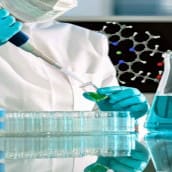Sanofi Genzyme
Funds Important Research

Neuronopathic Gaucher disease (nGD) is a devastating disease that affects infants, and is caused by severe mutations in the GBA1 gene. GBA1 encodes an enzyme called glucocerebrosidase. The enzyme deficiency in GD results in the accumulation of the lipid glucosylceramide and other metabolites in the lysosomes of cells, impairing their function in a number of tissues, including liver, spleen, bone marrow, bone and brain. The development of

Ricardo Feldman Ph.D. University of Maryland
enzyme replacement therapy (ERT) for GD was made possible by seminal studies by Dr. Roscoe Brady (see Summer 2016 Newsletter), who working at the NIH identified the genetic defect in GD as mutations in glucocerebrosidase, and made the critical observation that its uptake by Gaucher macrophages was facilitated by trimming some of the sugars in the enzyme used for treatment. ERT (Enzyme Replacement Therapy) has brought relief to many patients affected by type 1 GD, the non-neurological form of the disease, but because the therapeutic enzyme cannot cross the blood-brain-barrier, ERT cannot be used to prevent the neurological damage in nGD, which is irreversible. Many laboratories are working intensely to find new treatments for nGD.
Our Laboratory’s Focus
Our laboratory is focused on understanding the mechanisms by which GBA1 deficiency causes neurological damage (brain disease), as this approach may point to new targets for treatment. As GBA1 mutations are also a major risk factor for developing Parkinson’s disease, what is learned from studying nGD may also help prevent, ameliorate or reverse the loss of dopaminergic neurons in Parkinson’s disease. A major difficulty to study the pathological events leading to nGD is that neurons from patients harboring GBA1 mutations have not been available.
Reprogramming Technology
To circumvent this problem, our laboratory has used a novel reprogramming technology developed by Shinya Yamanaka, 2012 Nobel Laureate, which enabled us to generate these precious neurons from GD patients. In a process akin to biological alchemy, by introducing four reprogramming factors into fibroblasts obtained from skin biopsies of patients affected by all clinical subtypes of GD, we generated a panel of induced pluripotent stem cells (iPSC), with coverage of some of the most frequent GBA1 mutations, including N370S, L444P, RecNciI, and D409H. iPSC have two major properties that make them invaluable for disease modeling and therapeutic development. iPSC are self-renewing, providing unlimited numbers of cells for study, and they are capable of differentiating into virtually any cell type. By directed differentiation of GD iPSC to the cell types that are affected in nGD, we identified cellular abnormalities that recapitulate clinical manifestations, and have developed cell-based assays to identify new drugs that can reverse the abnormalities caused by GBA1 deficiency.
Neuroinflammation & Neuronal Cell Death in nGD
When we carried out directed differentiation of GD iPSC harboring severe mutations into blood cells, bone-forming cells, and neurons, we found that these cell types have major abnormalities. GD iPSC-derived macrophages have a striking delay in clearance of ingested red blood cells, recapitulating a hallmark of GD, in which pathological macrophages containing remnants of red blood cells accumulate in bone marrow, liver and spleen. GD iPSC-derived macrophages were also found to secrete abnormally high levels of inflammatory mediators, in line with observations that these mediators are elevated in patient serum. It is believed that microglia, the brain cells that perform similar functions as macrophages, are persistently activated, leading to neuroinflammation, a key event leading to neuronal cell death in nGD. We also found that GD iPSC-derived osteoblasts, which are bone-forming cells, have developmental and lysosomal abnormalities that preclude the deposition of bone matrix. Using nGD iPSC-derived neurons, we found that GBA1 mutations interfere with the function of TFEB, a factor involved in the formation and normal functions of lysosomes, leading to neuronal cell death. Our studies showed that GD iPSC-derived cells reproduced cellular abnormalities seen in patients, validating the use of this system to model the disease. The use of iPSC-based assays developed in our laboratory is also facilitating drug discovery.
Implications for Parkinson’s Disease
A major advantage of using patient-derived iPSC is that this system enables us to follow the development of affected cell types in a step-wise manner that recapitulates human development from the earliest, egg-like pluripotent stage. Our finding that blood and bone-forming cells in GD have developmental defects is prompting us to examine whether neuronal development is also compromised by GBA1 deficiency. The answer to this question has important clinical implications because if developmental networks are affected, their identification would bring to light early diagnostic markers, and a new set of drug targets that could be used for treatment, before the damage to the nervous system becomes irreversible. The outcome of this line of inquiry also has implications for the treatment of GBA1-associated Parkinson’s disease, as waiting for the onset of this disease to start treatment, when a substantial fraction of dopaminergic neurons may have already been lost, may be too late for effective pharmacological intervention.
Our laboratory is very grateful to Sanofi Genzyme and the CGRF for generous funding that will enable us to find answers to these important questions.
Glossary
ERT
“Enzyme Replacement Therapy … Intravenous infusion into patients of a pharmaceutical preparation of the enzyme; the infused enzyme cannot cross the blood-brain-barrier”
Fibroblasts
“Skin cells”
GBA1 gene deficiency
“GBA1 is a gene in the body that when mutated does not work correctly”
Glucocerebrosidase
“An enzyme that is needed for good health and is encoded by the GBA1 gene. This enzyme prevents the abnormal accumulation in the body of a lipid substance called Glucosylceramide”
Glucosylceramide
“A lipid in cells that is digested (broken down) by the enzyme Glucocerebrosidase”
Mutation
“A gene mutation is a permanent alteration in the DNA sequence that makes up a gene, such that the sequence differs from what is found in most people.”
Pluripotent Stem Cells
“Also referred to as iPS cells, are cells taken from any tissue (usually skin or blood) from a child or adult and is genetically modified to behave like an embryonic stem cell. As the name implies, these cells are pluripotent, which means that they have the ability to form all adult cell types.”






